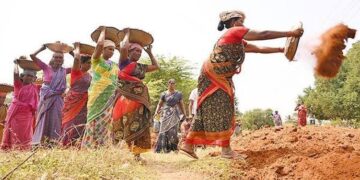Chili-Kalan Heat – A tragedy with a difference
By: Dr.Masoon Ahmad Beig
In the shadow of the towering Himalayas, the once-snow covered valleyduring Chili-kalan in Kashmir today bears witness to a terrible narrative written in the lack of rain and snow, coupled by a steady rise in temperatures. The air, once fresh with the promise of a cool winter breeze, now bears the weight of a looming ecological disaster. The continuous rise in temperatures puts a cloud over this region, upsetting the delicate equilibrium that has supported life for millennia.
The lack of the soothing touch of snow, a characteristic feature of Chilikalan’s winters, transforms the area into a barren scene, with whispers of dry winds replacing the comfortable calm of snowfall. The heavens, bereft of life-giving precipitation, convey a quiet narrative of thirst, while the ground underneath grows dry and cracked. In this melancholy symphony of climate change, Chili-kalan confronts a future that appears to disintegrate before its eyes, where natural rhythms are replaced by an eerie quiet, and the once vivid tapestry of the seasons fades into a mournful monotony of increasing temperatures and desolate landscapes.
The Chili-kalan is known for its biting cold, freezing snow and thick and impenetrable icicles. But this year it looks June already. The cool hill stations of valley are devoid of snow andevery day the temperature rises steadilyand as per IMD Srinagar, the temperature these days is 6.70 C above normal and Kashmir Valley is hotter than many northern states of India. This is not less than a tragedy because in future the rising temperature will have large scale impacts on various spheres of life.
The valley’s extreme fall in precipitation will result in a tragedy in the following months, as severe drought conditions will lead to a decrease in food grain output and, lastly, an invitation to food security in the valley.
The lack of snowfall will have an influence on glacier accumulation in the future, and the heat will accelerate glacier retreat, affecting river discharge and, as a result, agriculture owing to a lack of irrigation. Another tragedy is that the present dry spell and extreme heat have drastically reduced river flow, which has damaged dam refilling and negatively impacted hydropower output. As a result, we are currently experiencing long-term curtailments and frequent power outages. If things stay this way, things might get worse.
The ongoing January heat may cause early flowering of plants in Kashmir, potentially causing negative impacts on agricultural practices. The risk of late spring frost, which could damage delicate flowers, could lead to reduced fruit yields and impact farmers’ livelihoods. The altered timing of flowering may also disrupt ecosystems, increasing pest and disease pressure, potentially compromising the health and productivity of fruit trees. The mismatch between flowering periods and pollinator availability could hinder pollination, reducing fruit set and impacting crop yields. The early flowering may coincide with inadequate water availability, exacerbating farmers’ challenges.
Lack of snow will halt winter sports and tourism businesses. Ski resorts and facilities shall remain out of business leading to financial issues. Local athletes also face challenges as they have fewer opportunities to train and compete. The economic impact extends to cultural and recreational aspects of winter, such as festive events and traditional activities.
Winter droughts may cause environmental issues in future such as water stress, increased fire risk, soil erosion, and increased disease and pest susceptibility in forests, trees, and agriculture. This disrupts natural cycles, disrupts plant-pollinator synchrony, and affects crop growth and productivity.
It is quite likely that thefruit quality may decline due to reduced juice content and reduced flavour, making stressed plants more vulnerable to pests and diseases. The lack of snow in Chili-kalan will cause drought conditions and affect agriculture and livestock too.
Snow is a crucial water source and its scarcity is sure to disrupt irrigation practices, affecting staple food grain production. The lack of snow will also affects natural pasture growth and fodder availability, affecting livestock’s health and reproduction rates. This leads to reduced meat and milk production, weakened health, and reduced reproduction rates.
The disruption of natural habitats in Kashmir will cause a decline in biodiversity further leading to social and economic strains. The crumbling economy will cause migration and displacement among communities. The story of dwindling rain and snow calls for collective efforts besides ‘NimazeIstisqa’ and traditional ‘Susras’ there is a need to implement sustainable practices and adaptive strategies to maintain the region’s resilience.
Author teaches Geography at Government Degree College Kulgam






